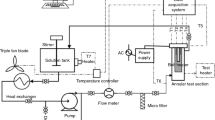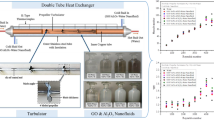Abstract
Heat transfer during pool boiling of subcooled pure water and water with the addition of Al2O3 microparticles is considered. The presented brief literature review indicates a clearly insufficient experimental base, without which it is impossible to talk about a direct dependence of the critical heat flux on the concentration of particles in a liquid. The methods used in the considered publications for studying heat transfer during boiling do not give a complete picture of the entire process and do not allow one to draw unambiguous conclusions. In the present work, the main research method was gradient heatmetry. The applied heterogeneous gradient heat flux sensors made it possible to directly obtain local the heat flux (HF) and proved to be a reliable tool in the study of phase transitions in a unsteady formulation of the problem. The article considers three temperature differences, 384, 391, and 400°C, selected based on the resource of the model (time of uninterrupted operation of the model and primary converters) and in view of the stable film boiling mode characteristic of the critical the heat flux (HF). In the entire studied range of mass concentrations of Al2O3 microparticles from 1 to 4%, an augmentation of heat transfer was observed during boiling of subcooled water at atmospheric pressure. The critical HF for the considered temperature differences turned out to be 3.6–5.1 times higher than for pure water. For each temperature regime, the optimal concentrations of Al2O3 microparticles (particles) corresponding to the maximum HF were revealed. An increase in the critical temperature in all regimes and, as a consequence, in the Heat Flux Per Unit Area is presumably due to a change in the thermophysical properties of the suspension and the perturbations introduced by these particles into the boiling process.













Similar content being viewed by others
REFERENCES
D. A. Labuntsov, Physical Fundamentals of Power Engineering: Selected Works on Heat Transfer, Hydrodynamics, and Thermodynamics (Mosk. Energ. Inst., Moscow, 2000) [in Russian].
S. S. Kutateladze, Fundamentals of Heat Transfer, 5th ed. (Atomizdat, Moscow, 1979) [in Russian].
Yu. V. Vilemas, G. I. Voronin, B. V. Dzyubenko, G. A. Dreitser, E. V. Dubrovskii, A. A. Zhukauskas, S. G. Zakirov, V. M. Ievlev, E. K. Kalinin, V. M. Shimonis, A. A. Shlanchyauskas, and S. A. Yarkho, Advances of Heat Transfer, Vol. 2: Heat Transfer Enhancement, Ed. by A. A. Zhukauskas and E. K. Kalinin (Mokslas, Vilnius, 1988) [in Russian].
B. V. Dzyubenko, Yu. A. Kuz’ma-Kichta, A. M. Kutepov, I. P. Sviridenko, A. I. Leont’ev, I. I. Fedik, V. V. Kharitonov, and A. P. Kholpanov, Heat and Mass Transfer Enhancement in Power Engineering (TsNIIAtominform, Moscow, 2003) [in Russian].
K. D. Sarit, P. Nandy, and R. Wilfried, “Pool boiling characteristics of nano-fluids,” Int. J. Heat Mass Transfer 46, 851–862 (2003). https://doi.org/10.1016/S0017-9310(02)00348-4
S. M. You, J. H. Kim, and K. H. Kim, “Effect of nanoparticles on critical heat flux of water in pool boiling heat transfer,” Appl. Phys. Lett. 83, 3374–3376 (2003). https://doi.org/10.1063/1.1619206
M. A. Morozova, Thermal Conductivity and Viscosity of Nano-Fluids, Candidate’s Dissertation in Mathematics and Physics (Kutateladze Inst. of Thermophysics, Siberian Branch of the Russian Academy of Sciences, Novosibirsk, 2019).
K. Basavaraj, K. Elangovan, S. N. Kulkarni, and S. Shankar, “Effect of concentration of Al2O3 nano particles in base fluid on thermal and flow properties to enhance the heat transfer rate,” Int. J. Eng. Res. Technol. 10, 106–112 (2021).
V. I. Terekhov, S. V. Kalinina, and V. V. Lemanov, “The mechanism of heat transfer in nanofluids: State of the art (review). Part 2. Convective heat transfer,” Thermophys. Aeromech. 17, 157–171 (2010).
S. Mukherjee, S. Ebrahim, C. M. Purna, A. Naser, and P. Chaudhur, “A review on pool and flow boiling enhancement using nanofluids: Nuclear reactor application,” Processes 10, 177 (2022). https://doi.org/10.3390/pr10010177
V. V. Yagov, A. R. Zabirov, and M. A. Leksin, “Unsteady heat transfer during subcooled film boiling,” Therm. Eng. 62, 833–842 (2015). https://doi.org/10.1134/S0040601515110117
A. V. Dedov, A. R. Zabirov, A. P. Sliva, S. D. Fedorovich, and V. V. Yagov, “Effect of coating by a carbon nanostructure on heat transfer with unsteady film boiling,” High Temp. 57, 63–72 (2019). https://doi.org/10.1134/S0018151X19010048
A. V. Vintsarevich, A. V. Mityakov, D. V. Gerasimov, and M. V. Yamashkin, “Research of heat transfer in combustion chamber of diesel engine on idle by gradient heat flux measurement method,” J. Phys.: Conf. Ser. 1565, 012019 (2020). https://doi.org/10.1088/1742-6596/1565/1/012019
A. A. Gusakov, M. A. Grekov, and V. V. Seroshtanov, “Aerodynamics and heat transfer over the surface of a single circular fin,” Nauchno-Tekh. Vedomosti SPbGPU, Fiz.-Mat. Nauki 11 (2), 151–164 (2018). https://doi.org/10.18721/JPM.11214
S. Z. Sapozhnikov, V. Yu. Mityakov, A. V. Mityakov, A. Y. Babich, E. R. Zainullina, and A. V. Pavlov, “Searching of the optimum tilt of the pipe at condensation by using gradient heatmetry,” J. Phys.: Conf. Ser. 1683, 022028 (2020). https://doi.org/10.1088/1742-6596/1683/2/022028
S. Z. Sapozhnikov, V. Yu. Mityakov, A. V. Mityakov, A. A. Gusakov, A. V. Pavlov, and P. G. Bobylev, “Investigation of boiling on the surface of a ball by the method of gradient heatmetry,” Tepl. Protsessy Tekh. 13 (10), 434–441 (2021).
S. Z. Sapozhnikov, V. Yu. Mityakov, A. V. Mityakov, A. V. Pavlov, P. G. Bobylev, and M. D. Vinogradov, “Gradient heatmetry in the study of boiling on spherical surface,” J. Phys.: Conf. Ser. 1867, 012015 (2021). https://doi.org/10.1088/1742-6596/1867/1/012015
S. Z. Sapozhnikov, V. Yu. Mityakov, A. V. Mityakov, A. Yu. Babich, and E. R. Zainullina, “The study of heat flux measurement for heat transfer during condensation at pipe surfaces,” Tech. Phys. Lett. 45, 321–323 (2019).
S. Z. Sapozhnikov, V. Yu. Mityakov, and A. V. Mityakov, Heatmetry: The Science and Practice of Heat Flux Measurement (Springer, St. Petersburg, 2020).
V. Yu. Mityakov, A. V. Pavlov, and P. G. Bobylev, “Creation and calibration of primary converters based on copper–nickel composition,” in Science Week of St. Petersburg Polytechnic University: Proc. 29th All-Russian Conf., St. Petersburg, Russia, Nov. 18–23, 2019 (Politekhpress, St. Petersburg, 2020).
S. Nukiyama, “The maximum and minimum values of the heat Q transmitted from metal to boiling water under atmosphere pressure,” Int. J. Heat Mass Transfer 27, 959–970 (1984).
A. R. Zabirov, V. V. Yagov, V. A. Ryazantsev, I. A. Molotova, and M. M. Vinogradov, “Decrease of Leidenfrost temperature at quenching in subcooled liquids,” J. Phys.: Conf. Ser. 2116, 012010 (2021). https://doi.org/10.1088/1742-6596/2116/1/012010
I. C. Bang and S. H. Chang, “Boiling heat transfer performance and phenomena of Al2O3–water nano-fluids from a plain surface in a pool,” Int. J. Heat Mass Transfer 48, 2407–2419 (2005). https://doi.org/10.1016/j.ijheatmasstransfer.2004.12.047
Funding
The work was funded by the Russian Science Foundation (grant no. 22-29-00160, https://rscf.ru/project/22-29-00160).
Author information
Authors and Affiliations
Corresponding author
Rights and permissions
About this article
Cite this article
Pavlov, A.V., Bobylev, P.G. & Sapozhnikov, S.Z. Gradient Heatmetry in Study of Heat Transfer during Pool Boiling of Subcooled Water and Liquid with the Addition of Al2O3 Microparticles. Therm. Eng. 70, 194–202 (2023). https://doi.org/10.1134/S0040601523030060
Received:
Revised:
Accepted:
Published:
Issue Date:
DOI: https://doi.org/10.1134/S0040601523030060




